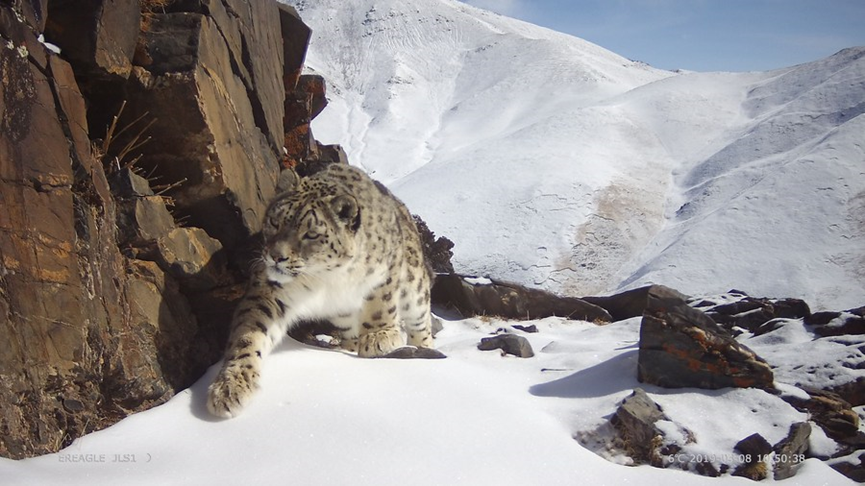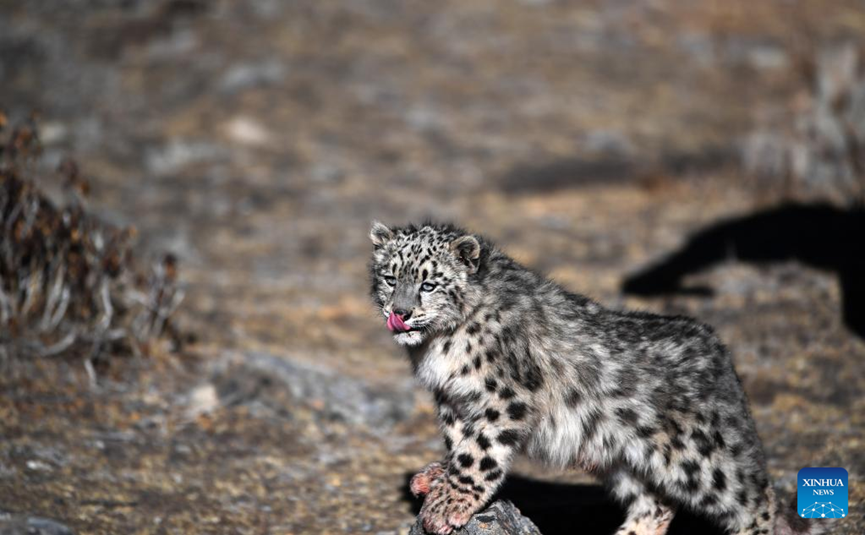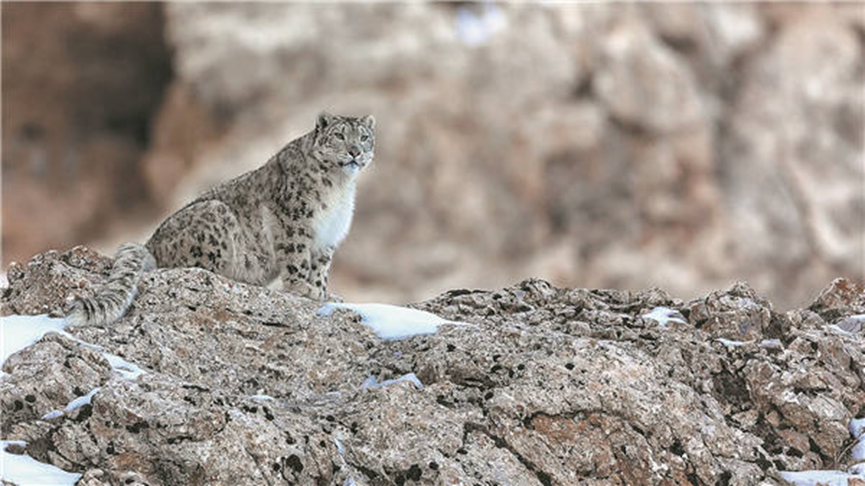Wang Dajun, PhD, a wildlife research and protection expert from Peking University's School of Life Sciences. [Photo by Xu Haoyu/China Daily]
Peking University, January 6, 2023: Rarely seen creature is being observed and studied in its natural habitat of the Qilian Mountains in Qinghai province, Xu Haoyu with China Daily reports.
The predator known as "king of the snowy mountains" is being watched and studied. This is taking place far from the lofty peaks of its habitat. It is being conducted in Tianjun county, Qinghai province's Haixi Mongolian and Tibetan autonomous prefecture, more than 400 kilometers away from the Laohugou Ecological Management and Protection Station, Menyuan Hui autonomous county of Qinghai.
Wang Dajun, Ph.D., a wildlife research and protection expert from Peking University's School of Life Sciences, is fascinated by the "big cat", the snow leopard, which resides in the Qinghai area of the Qilian Mountain National Park.
The snow leopard is the apex predator and dominating species of its high and cold environment, playing an irreplaceable role in maintaining the ecosystem. Mainly found on bare rock at altitudes of between 2,000 and 5,000 meters, it is a secretive species with a low population density.
"Monitoring snow leopards is like a 'game', a process of communication and mutual understanding between people and the natural world," says Wang.
Monitoring the species in the Qinghai area of the Qilian Mountains began in the middle of the 1980s, with sporadic snow leopard surveys based on interviews conducted on parts of the Shule Nanshan Mountain from 1996 to 1998.But few systematic and comprehensive field surveys and monitoring programs have been carried out in other areas.
After 19 years, the Qilian Mountain National Park pilot construction program was officially started in 2017, and comprehensive and systematic snow leopard monitoring and assessment is underway.
In five consecutive years of snow-leopard monitoring, an area of 4,172 square kilometers in the Qinghai area of the Qilian Mountain National Park has been discovered as potentially the main habitat of the creatures, with 95 reproduction and breeding points found and 105 snow leopards identified.
Photo: Xinhua/Chogo
In November 2021, the Qinghai administration bureau of Qilian Mountain National Park and Wang's team from Peking University formed a working group to carry out satellite tracking of snow leopards in Suli township, Tianjun county.
The process lasted 45 days, with 11 capture points set up and three snow leopards successfully caught.
Before putting on the tracking collars of the three snow leopards, Wang saw one of them huddled in its cage and thought that it was too small and not yet an adult, thus wearing a collar might affect its predation and growth, so he made the decision to set it free.
However, as it leapt out of the cage and fully stretched its body, Wang realized that it was already an adult.
Snow leopards in their natural habitat in Qinghai province. They are the apex predator and dominating species of its high and cold environment, playing an irreplaceable role in maintaining the ecosystem. BAO YONGQING/YAO MUYANG/XINHUA
The other two have experienced complete periodic satellite tracking and observation. So far, the two snow leopards have sent back a total of 1,660 items of positioning data from their tracking collars, with an activity area of 13.8 sq km and 42 sq km, respectively.
Ten days after releasing them, one of them was found in the wild, nursing two cubs, and the carcass of a Himalayan blue sheep Pseudois nayaur was found nearby. This crucially indicated that it was hunting normally with the collar.
Wang claims that obtaining accurate information on the snow-leopard population, its distribution, the individual life history of the cats, as well as their reproduction and survival habits, significantly promotes biodiversity conservation, as well as the construction and management of the national park.
By tracking snow leopards, Wang's team found that the density of the snow leopard population in the southern foothills of the Qilian Mountains, which are in the transition zone between the Qinghai-Tibet Plateau and the Hexi Corridor, was much higher than expected.
The findings of the research are also refreshing Wang's perception of snow leopards. Wang, who has had many chance encounters with snow leopards during his yearlong observation, proudly proclaims that there has never been a precedent of snow leopards actively attacking humans. He recalls that once he made tense, but generally friendly, contact with a snow leopard that he encountered at a rather close distance.
This file photo taken by an infrared camera shows a snow leopard in the Wenchuan area of the Giant Panda National Park in southwest China's Sichuan Province. (Photo/Xinhua)
"When I got close to the snow leopard, it would stretch its paws out, show its teeth to me and it let out a low growl. I stopped moving closer and just stood still staring at it. After a while, it suddenly laid down and started washing its face with its outstretched paws as if to relieve its anxiety," Wang says excitedly.
"It seems that the public perception is that the snow leopard is a fierce beast, but on the contrary, the snow leopards that I saw always move with grace and show a confident and comfortable posture, giving me the deep feeling that they are the real masters of their natural ecosystem."
"Gentle" is the word Wang uses to describe the snow leopard. It is not a large-sized carnivore; in fact, they only grow as tall as around 61 centimeters at shoulder height and are not as tough as the smaller "Chinese desert cat", Felis bieti, (Chinese mountain cat), he adds.
According to Wang, the team once spotted a snow leopard in the mountains, with its exposed tail revealing its location from a distance. It was only after they zoomed in with their camera that they realized the snow leopard was also watching them, with its eyes looking in their direction through a gap in the rocks.
"I often feel that, rather than us observing the snow leopard, it is the snow leopard that is observing us, and it is much easier for it to do so," Wang says. "Often, by tracking its positioning data, I know it remains very close to me. Even though I can't see it with my eyes, I know that it sees me. I want it to observe me more, as it could be very meaningful for our research.
"There are still many mysteries to be explored with the reclusive snow leopard, and our research and understanding of the animal have only just begun," Wang says.

Infrared photo taken on March 8, 2019 shows a snow leopard in Sanjiangyuan National Park in the Yushu Tibetan Autonomous Prefecture of northwest China's Qinghai Province. (Xinhua)
Wang claims that the research work has been helped by the growing awareness of the need for animal conservation among members of the local government and nearby residents. Additionally, he has heard from other experts, who are also working on animal conservation, that they have reached the same conclusion: The number of snow leopards is showing a significant increase.
He says that local people are becoming more aware that the area they live in is in need of protection. The government has introduced strong legislation pertaining to animal protection, and many conservation groups have sprung up among the people themselves.
"The religious beliefs of the local people make them revere living creatures, and on the Tibetan plateau, a place where resources are relatively scarce, people and animals both know how to cherish the gift of nature wisely and, at the same time, respect the equal relationship between people and nature," says Wang.
This article originally appeared in China Daily with the headline “On the trail of the elusive snow leopard.”
Source:
China Daily
Written by:
Xu Haoyu




